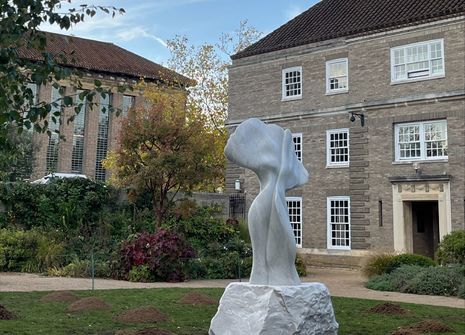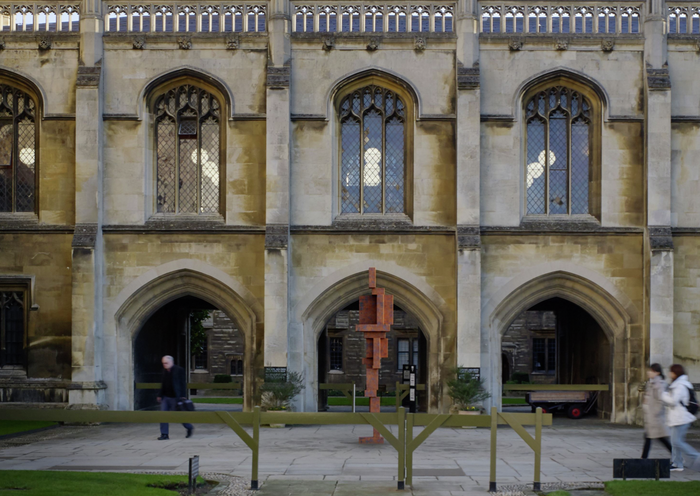How successful is new Clare sculpture as a ‘HOMMAGE’ to 50 years of co-education?
Despite being designed to commemorate 50 years of female education at Clare this ‘stereotypical representation of feminity’ does little to represent this anniversary

‘HOMMAGE’, a loaned sculpture by Helaine Blumenfeld OBE, was unveiled at Clare College on 21 October – the first in a series of events being run this year to mark the college’s 50th anniversary of co-education. Blumenfield specifically created the statue to celebrate this anniversary. And she remarks that the sculpture “takes its inspiration from this hard-fought decision and how it transformed the aspirations of young women.”
A stereotypical representation of femininity
The abstract sculpture consists of a rough-hewn marble block foundation. Carved strands grow out of this base, curving into each other to create a fragile and ‘whale-like’ fan. The movement of the statue with its changing textures and landscape expertly mimics the social change it wishes to evoke. The flow of movement is not just linear, but curves. Movement, just like the statue, shifts as you walk around it. This statue is designed to exist within a space people regularly pass. It offers something new at every glance, fitting to the sculptors’ ethos that “public art relies on a bond between sculpture and setting, and that bond is made complete by people – the people who use this space.”
The real beauty of the statue lies in its fluidity. It's a staple of Blumenfield’s sculpting, but also in her interest in representing the social progression that the statue stands for. This is reflected in the sculpture’s structure, reaching upwards and forwards— with one student describing it as a “bloom still to come into fruition.” However, many students stated that without the description, the artist’s intention behind the piece would be lost on them. They suggested that while it is beautiful, it does little to represent the anniversary it’s meant to commemorate. One student also argued that by its very aesthetic nature the statue becomes an “objectification”. They remark that the statue is “overly focused on purity or maybe, generously, elegance”— in this way becoming a stereotypical representation of femininity. Comparing ‘Homage’ with Blumenfield’s more imposing sculptures, like the ‘The Chauvinist’, you see what is meant by this review. In both these artworks, traditional concepts of the masculine and feminine that are so tied to social ideals appear in tension with their feminist purposes.
“Change can be as turbulent and fragile as it is exciting and generative”
The statue has been placed amongst the accommodation of the college in Ashby Court. The statue’s placement here allows it to feel like a part of the college space, while also being visible to those passing the Univerity Library. The ‘Homage’ is simultaneously public and private. It has also been placed in a way that allows it to be visible through the archways that connect the various courts, as well as from the entrance to the college library, itself currently decorated with photographic portraits of female fellows.
The unveiling was presented by the Master, Loretta Minghella OBE, who framed the statue within a dialogue of hope for continuing to improve inclusivity within the college. She explained that “as we embark on our programme of events to mark 50 years of co-education at Clare, we are taking time to reflect on the contributions made both in Clare and beyond by women who have taught and studied here.” She adds that the sculpture “reminds us that change can be as turbulent and fragile as it is exciting and generative and that we have to nurture the gains we’ve made and not just concentrate on the new.”
The event brought a moderate crowd of fellows, staff, alumni, and students— though the majority of the students in attendance chose to view the unveiling from the Library Common Room, rather than physically attending the event. The unveiling was accompanied by the choir. However, one student commented that this added to the event feeling saturated by your classic Cambridge “upper-middle-class pretensions” from which students felt distanced. A contrasting student perspective said that the event was “inspiring” despite being rather “short.” The unveiling of ‘Homage’ was followed by a talk from Professor Polly O’Hanton, a member of the first female co-cohort in 1972, helping to ground the occasion in the lived experience that the statue hopes to commemorate.
Next time you pass the UL and glimpse into Memorial Court, think about what this statue means to you. Think about how it wasn’t very long ago that only men would have been admitted into this college, and been able to engage and exist in this space. As you look, allow your eyes to wander in whatever direction that statue’s bends take you. And think about the future that we need to focus on carving out today.
 Features / Should I stay or should I go? Cambridge students and alumni reflect on how their memories stay with them15 December 2025
Features / Should I stay or should I go? Cambridge students and alumni reflect on how their memories stay with them15 December 2025 News / Cambridge study finds students learn better with notes than AI13 December 2025
News / Cambridge study finds students learn better with notes than AI13 December 2025 News / Dons warn PM about Vet School closure16 December 2025
News / Dons warn PM about Vet School closure16 December 2025 News / News In Brief: Michaelmas marriages, monogamous mammals, and messaging manipulation15 December 2025
News / News In Brief: Michaelmas marriages, monogamous mammals, and messaging manipulation15 December 2025 Comment / The magic of an eight-week term15 December 2025
Comment / The magic of an eight-week term15 December 2025









